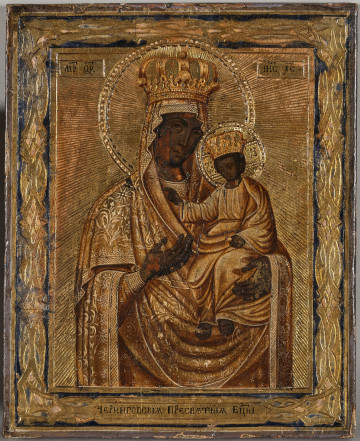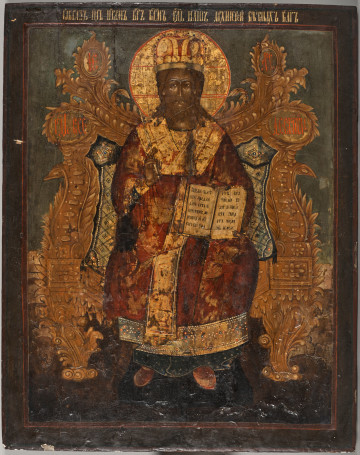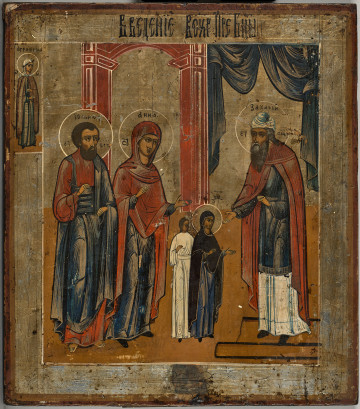
The Mother of God of Hodigitria
19th (?) century
Castle Museum in Łańcut
Part of the collection: Ikony
The icon of the Mother of God Joy of the Afflicted or Joy of All Who Sorrow enjoyed popularity since the miraculous healing of Euphymia, the sister of Patriarch Joachim, in 1688, see S.12772MŁ. The depiction appeared in diverse compositional variants. One of the most widespread is the Mother of God with a scepter in hand, standing among the suffering, the needy, and the sick, in the presence of angels. Usually, on the banderoles in the background, there are words of a liturgical hymn - a sticheron, from which the depiction took its name: "O Virgin Theotokos, full of Grace, Joy of all who sorrow...". Not infrequently, depictions of this type were cast as individual plaques. On the displayed icon, the middle pictorial field is surrounded by a decorative border with depictions in medallions: by the top edge, there is the Deesis (Christ with the revering Mother of God and John the Baptist), by the bottom and side edges - archangels and prophets. To make a casting like this one, two separate models - of the icon and of the border - were combined into a single imprint in the moulding box. After imprinting the model and taking it out, the box was closed and molten metal was poured into it; after it cooled, a single-part plaque was retrieved. In this way, for subsequent casts, models of other images could be used in place of the central icon, using the same border. The tradition of cast metal objects of worship was brought to Rus from Byzantium. Since the end of the 17th c., it was perfected and spread by the Old Believers, also known as Old Ritualists, who did not accept the liturgical reform and did not use icons other than their own, see S.12800MŁ, S.12835, S.12863MŁ. In the 19th c. Russia, in addition to high-class producers, many small domestic casting workshops were established. The demand for icons and other brass objects of worship was high not only among the Old Believers but also among those faithful to the Orthodox Church of the Moscow Patriarchate. Teresa Bagińska-Żurawska https://orcid.org/0000-0002-9243-3967
Dimensions
height: 14.2 cm, width: 12.2 cm
Object type
Icons
Technique
cast
Material
brass
Origin / acquisition method
decyzja administracyjna
Creation time / dating
Creation / finding place
Owner
Castle Museum in Łańcut
Identification number
Location / status

19th (?) century
Castle Museum in Łańcut

1800 — 1850
Castle Museum in Łańcut

1800 — 1899
Castle Museum in Łańcut
DISCOVER this TOPIC
Museum of King Jan III's Palace at Wilanów
DISCOVER this PATH
Educational path